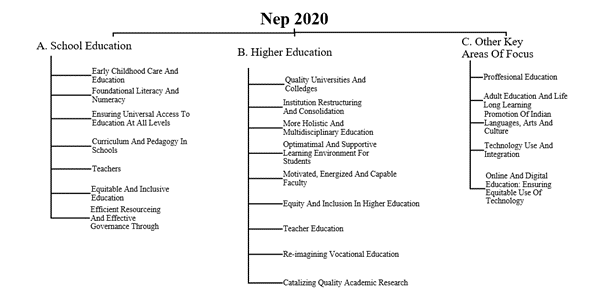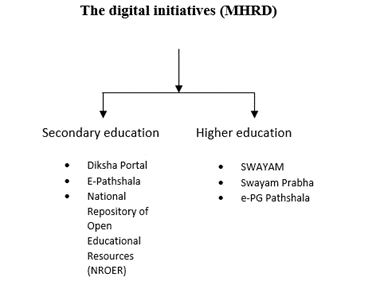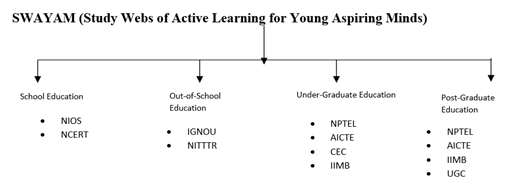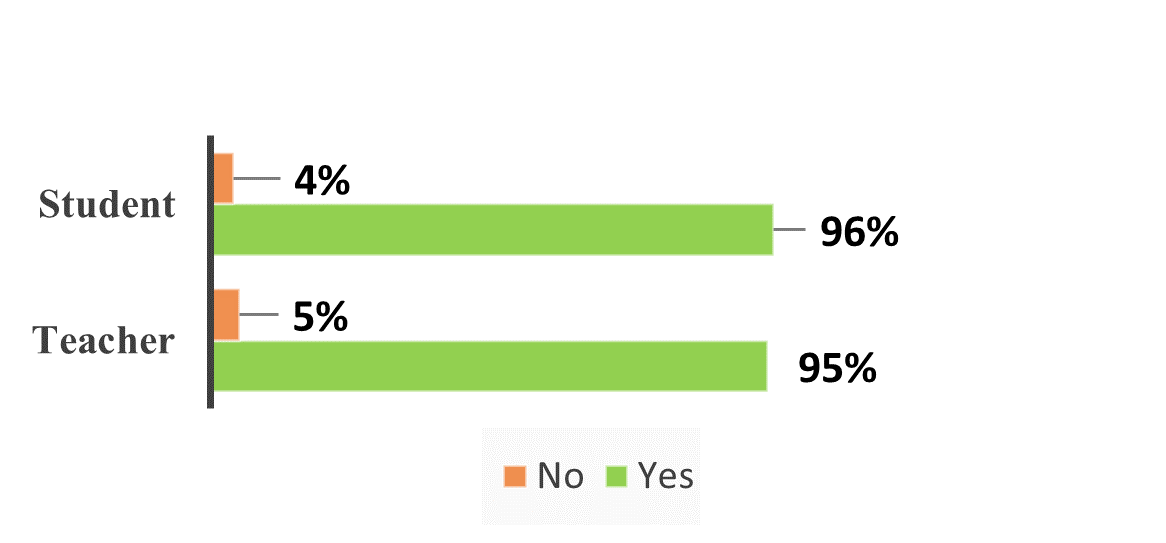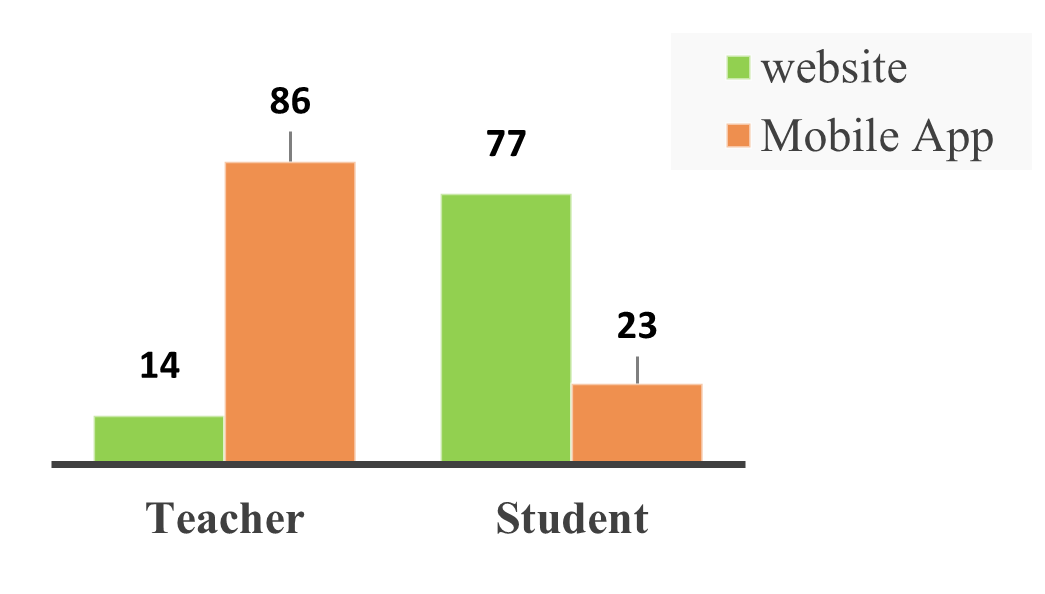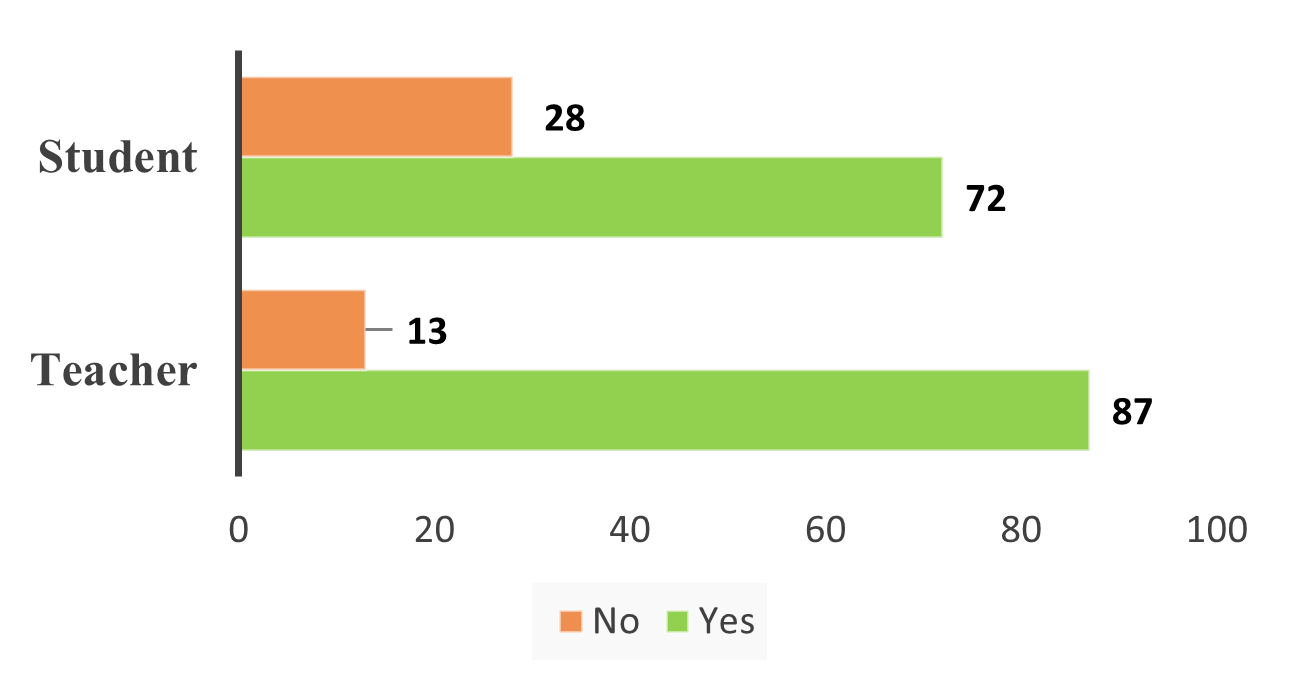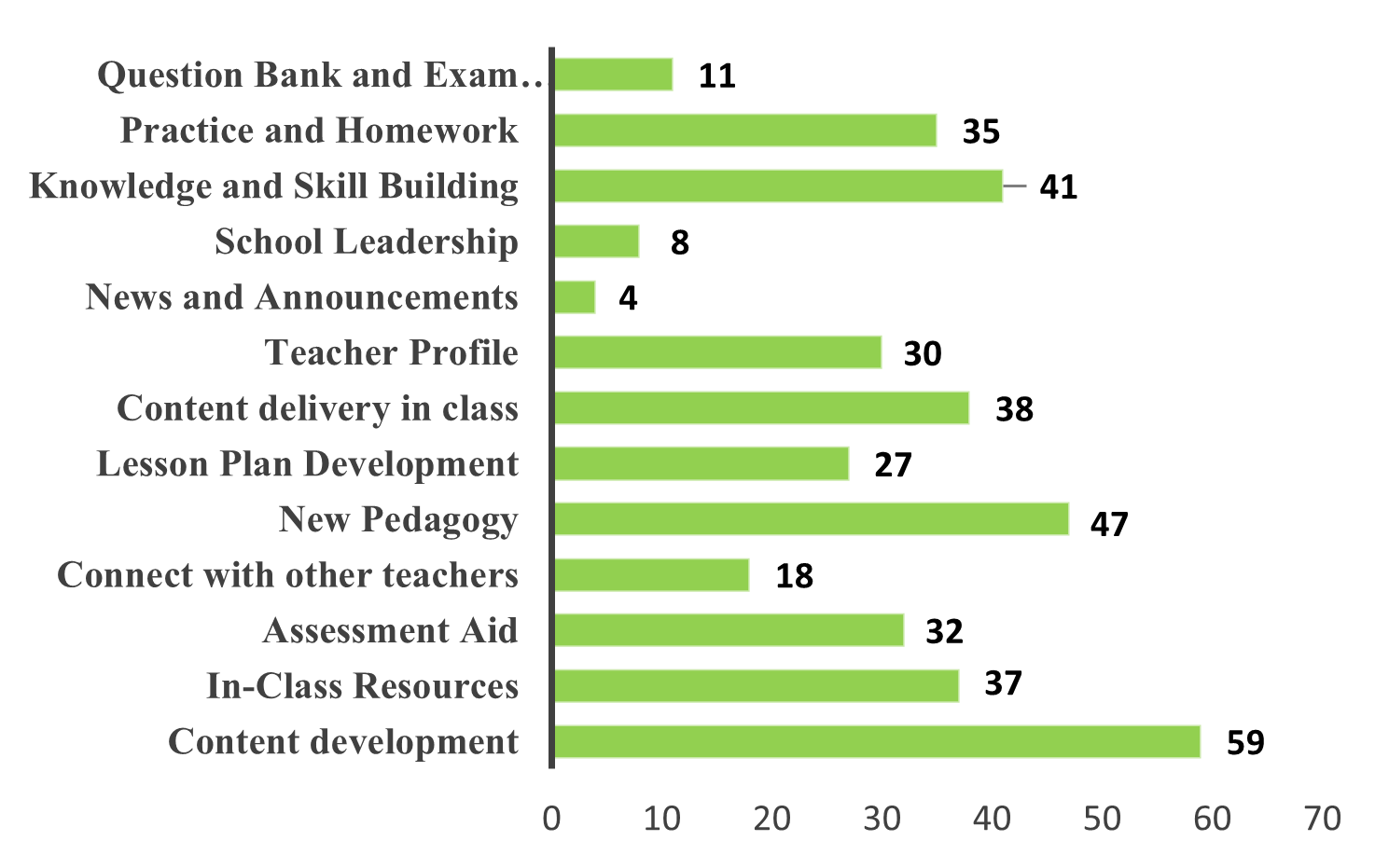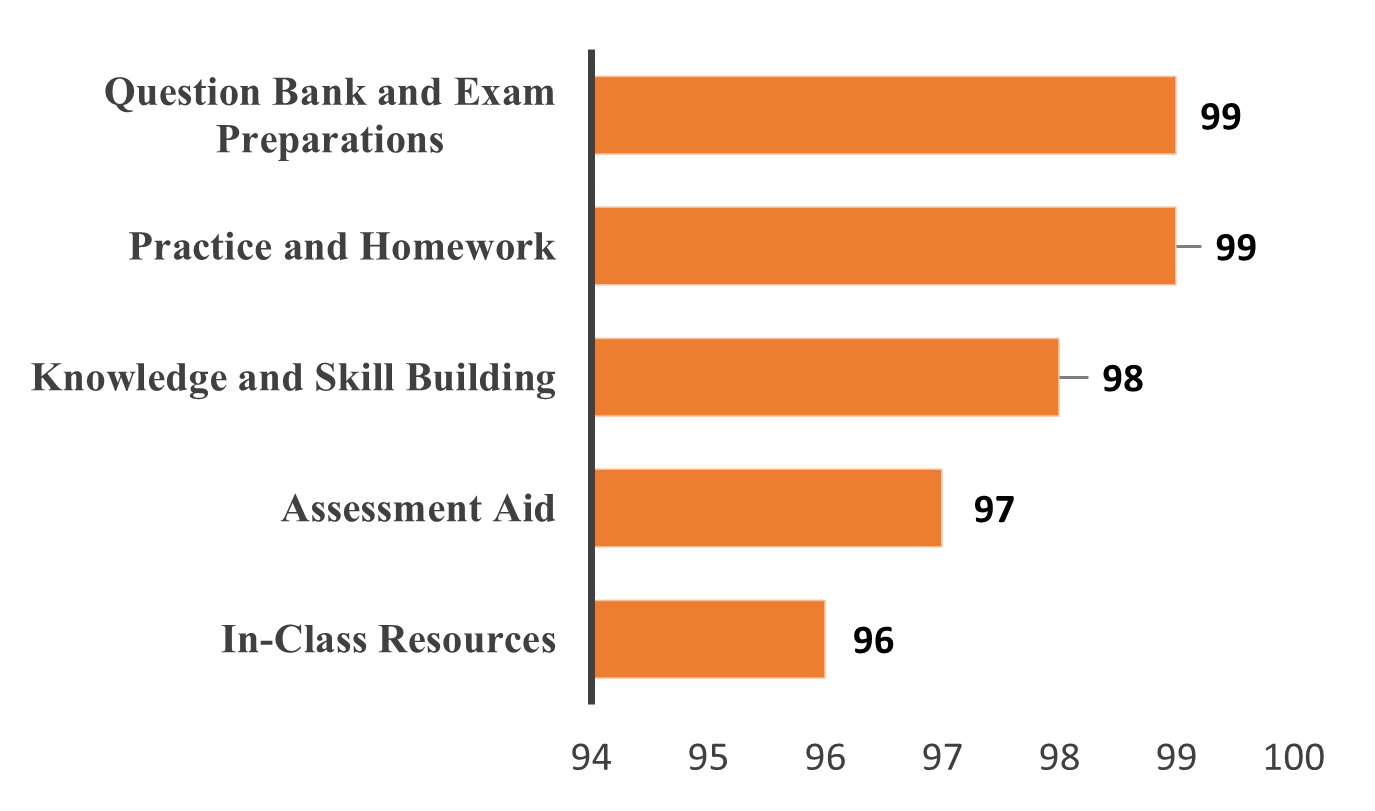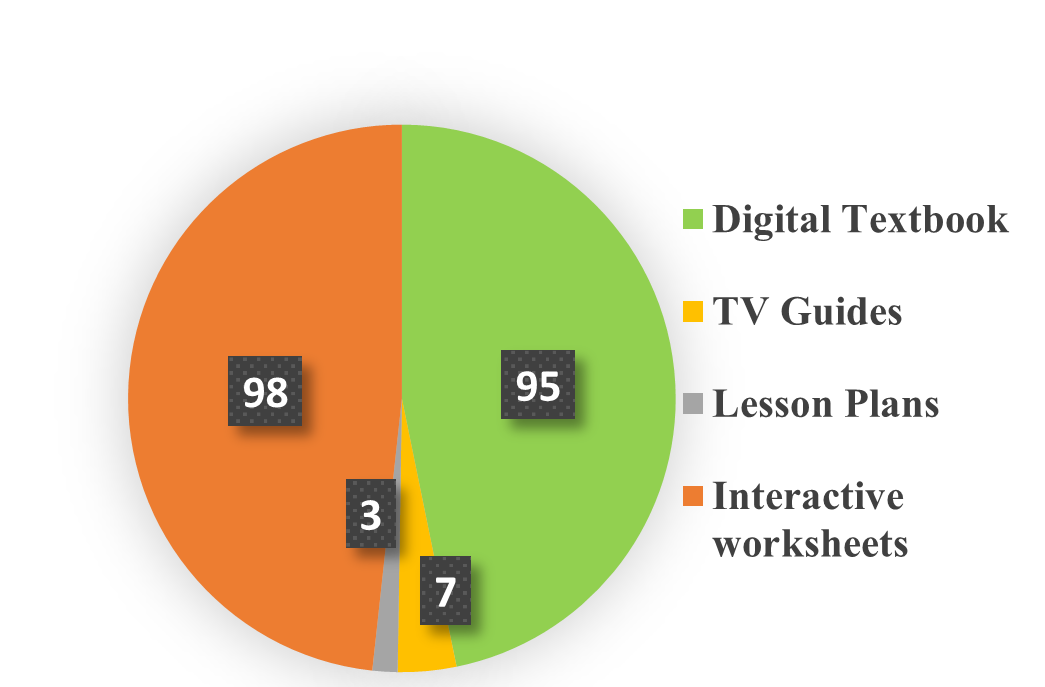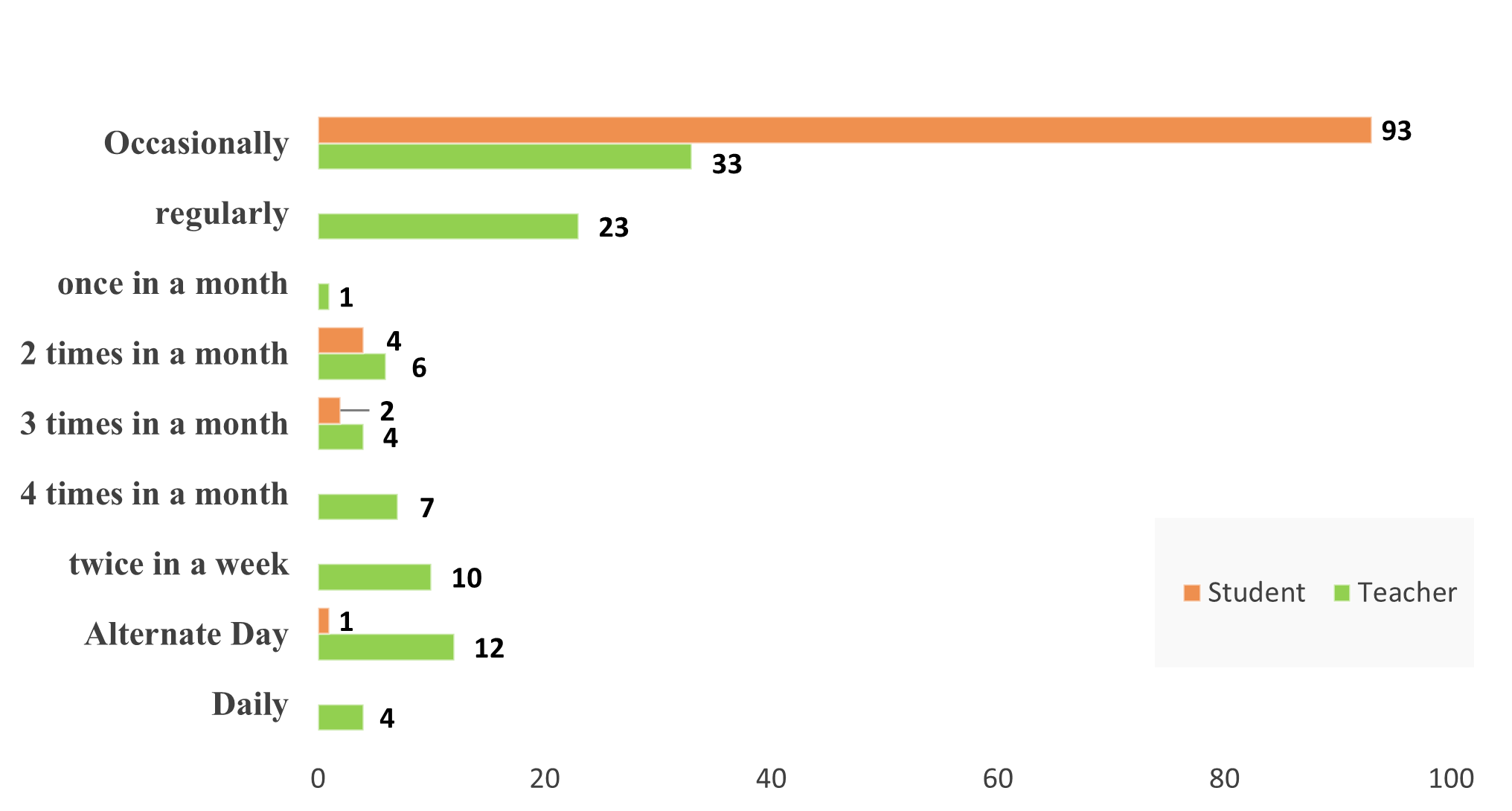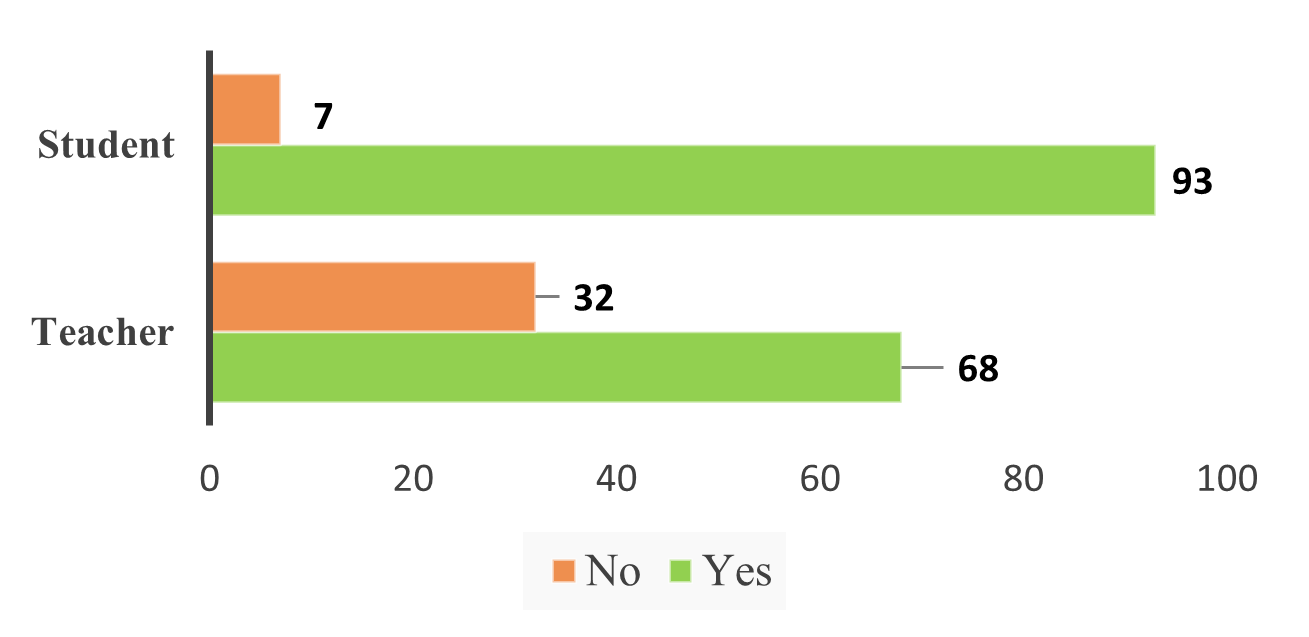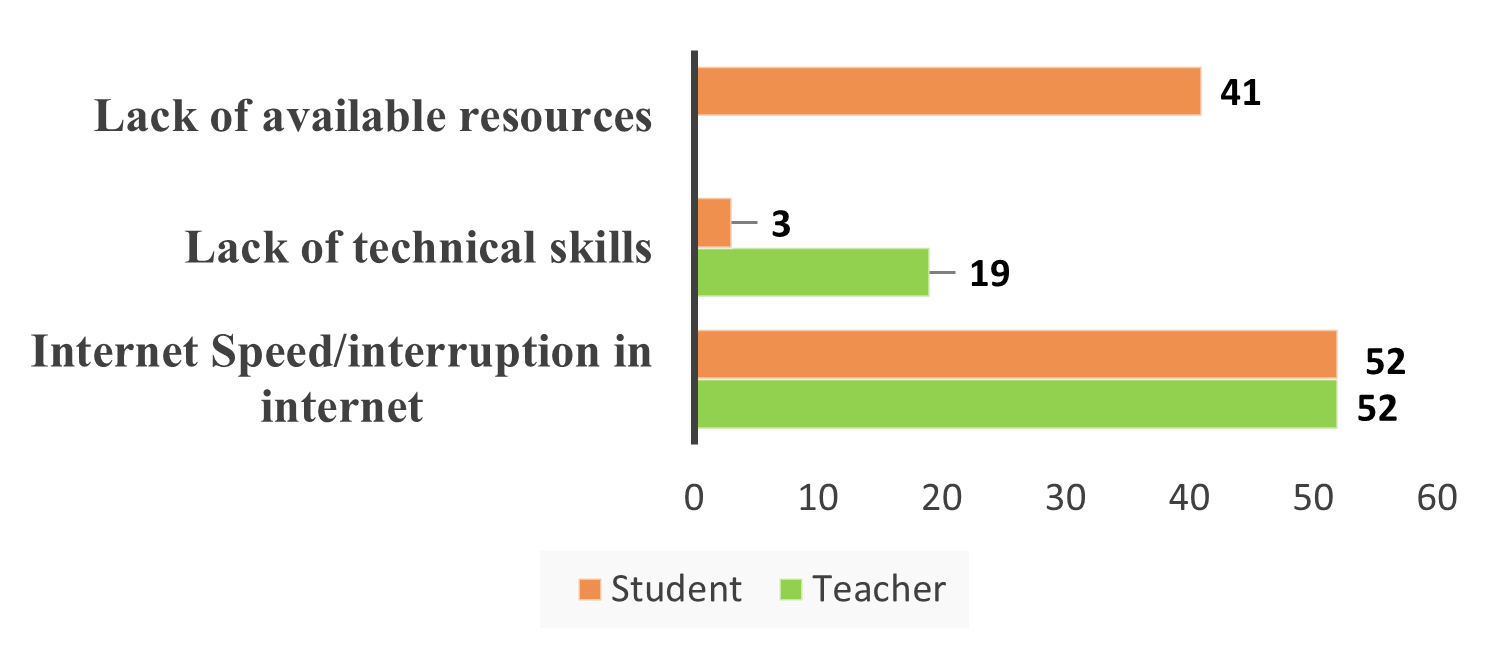A Study on Access and Use of Diksha for School Teachers amid Covid-19 in Rajasthan
- Dr. Ratna Verma
- Dr. Debendra Nath Dash
- Ms. Mahima Purohit
- 21-37
- Jun 27, 2024
- Education
A Study on Access and Use of Diksha for School Teachers amid Covid-19 in Rajasthan
Dr. Ratna Verma1, Dr. Debendra Nath Dash2, and Ms. Mahima Purohit3
1Associate Professor, IIHMR University, Jaipur
2Assistant Director, Mahatma Gandhi National Council of Rural Education, Hyderabad, MoE
3Research Officer, IIHMR University, Jaipur
DOI: https://doi.org/10.51244/IJRSI.2024.1106003
Received: 07 May 2024; Revised: 22 May 2024; Accepted: 27 May 2024; Published: 27 June 2024
ABSTRACT
The COVID-19 pandemic has severely affected all sectors across the globe and has also led to unprecedented disruptions in the education sector worldwide, particularly affecting rural communities in India. With the closure of schools and educational institutions, online education emerged as the primary option to ensure continuity of education. This study focuses on assessing access and use of the online education platform DIKSHA amid the COVID-19 pandemic in rural areas, specifically examining the implementation and impact of digital education initiatives on teaching and learning. The study was conducted using quantitative and qualitative methods for data collection. The study covered 100 teachers and 100 students who were actively using the DIKSHA portal during the lockdown of the COVID-19 pandemic. Data were collected from 30 villages located in Jaipur and Udaipur districts of Rajasthan, India. The study findings indicate that a significant proportion of teachers and students are aware of the existence and usefulness of these platforms. However, the majority of participants encountered difficulties in effectively utilizing the online portals, with issues related to internet speed and interruptions being the predominant challenge. These challenges underscore the urgent need for improvements in digital infrastructure, connectivity, and comprehensive training programs to ensure that online educational platforms can effectively bridge the education gap and provide maximum benefits to students in rural regions.
Keywords: COVID-19, DIKSHA, Online Education, Teachers, Students.
INTRODUCTION
As enshrined in the Indian constitution, under Article 21-A, the fundamental right of access to education is of immense importance for a nation’s overall development. Education plays a pivotal role in improving a person’s knowledge, skills, attitude, personality, and values, thus enabling him to meet the challenges of daily life. In the modern and competitive society where we live, education has become indispensable. It not only enriches lives but also serves as a benchmark for societal and national growth in terms of socio-economic, cultural, and political aspects. Therefore, access to quality education is crucial to respond to the ever-changing landscape of a nation. In India, education is a significant component of the growth and development of the whole society, especially in emerging economies, with implications for economic, social, and technological foundations. India has one of the largest education systems worldwide with more than 1.55 million schools managed by the state governments (Department of School Education & Literacy, 2021) However, ensuring equal access and quality education for all remains a major challenge, especially in bridging the education gap between the affluent and marginalised sections of society.
To promote educational equity and to bridge the education gap, the government of India initiated several steps respectively. Goal 4 of the Sustainable Development Goals (SDGs) for 2030 was adopted by India in 2015, and it focuses entirely on providing inclusive and equitable quality education and lifelong learning opportunities for all. In keeping with this purpose, the (NEP) 2020 National Education Policy was implemented to address the country’s evolving development demands. The need to employ technology and digital platforms to improve education is emphasised in the NEP 2020. The policy recognizes the benefits and potential risks of technology and emphasises the need to bridge the digital divide and ensure equal access to online and digital education. It calls for pilot studies, the development of digital infrastructures, online teaching platforms and tools, content creation and distribution, and the use of mass media for educational broadcasting to meet diverse learning needs and ensure widespread support.
The Indian government imposed a lockdown in response to widespread infection with the COVID-19 virus (Joshi et al., 2020). The pandemic adversely impacted all sectors of the country’s economy, with the education sector being the hardest hit (Gupta et al., 2020). Amid the COVID-19 pandemic, when traditional offline education channels became inaccessible due to lockdowns and social distancing, online education platforms became the primary means for educational institutions to continue providing learning opportunities to school children. The crisis was a challenge but at the same time, it provided an opportunity for educational institutions to advance their technical knowledge and digital infrastructure. The government’s digital India vision and several initiatives at the ministry level facilitated the continuation of education through online portals, educational channels, and digital learning platforms. However, there has also been a shift towards online education as a new solution during the pandemic. This shift highlights the importance of evaluating the effectiveness of online education platforms, especially in rural India where access to technology and digital infrastructure is limited.
This research focuses on evaluating the effectiveness of access and use of online education platforms amidst COVID-19 in rural India. It aims to assess the implementation and impact of digital education initiatives such as the DIKSHA platform to ensure continuity of education and bridge the education gap during the pandemic. By analysing the policies, infrastructure, and challenges related to online education, this study aims to provide valuable insights and recommendations to strengthen digital education’s effectiveness in rural India. The study on the effectiveness of access and use of online education platforms amidst COVID-19 in rural India expanded the scope of opportunities for teachers and parents to use digital learning, reflect on their experiences, and further build prospects of using DIKSHA. It addresses the urgent need to assess the impact of online education in rural areas, provides insights into barriers and facilitators, contributes to educational equity, and informs policy decisions. The findings can guide interventions and investments to ensure that children and youth in rural India have equitable access to quality education during crisis such as COVID-19 and in the long run.
PURPOSE
The major purpose of this study is to assess the effectiveness of access and use of online education platforms, particularly the DIKSHA platform, amidst the COVID-19 pandemic amongst students and teachers in rural areas of Rajasthan, India. The study aims to assess the implementation and impact of digital education initiatives on teaching and learning, with a focus on bridging the education gap during the pandemic.
RESEARCH QUESTION
How effective is the access and use of online education platforms, specifically the DIKSHA platform, in rural areas of Rajasthan, India, amidst the COVID-19 pandemic?
METHODOLOGY
The methodology employed for the study involves an exploratory research design, combining primary and secondary research methods with both qualitative and quantitative analysis. The sample for this study consisted of 100 teachers and 100 students from rural areas of Rajasthan who have used the DIKSHA online education portals during the COVID-19 lockdown.
A Two-Stage Random Sampling approach was used to determine the sample size. Schools were picked in the first stage, followed by teachers and students in the second. The study was conducted in 30 villages of Jaipur district and Udaipur district, Rajasthan. The study covered 40 schools: 20 schools each from the Jaipur and Udaipur districts in Rajasthan. The sample size of 100 students and 100 teachers is based on a representative proportion of the total population of teachers and students in government schools of each village. A total of 200 students and teachers were randomly selected from each village to ensure a diverse representation. The study focuses on government schools in these two districts and involves teachers and students who have used the DIKSHA portal. The distribution of respondents is as follows:
Table 1 Sample Size Distribution by District
| District | Teachers | Students | Total sample size |
| Udaipur | 50 | 50 | 100 |
| Jaipur | 50 | 50 | 100 |
| Total | 100 | 100 | 200 |
By employing this methodology, this research endeavors to acquire comprehensive insights into online education’s effectiveness in rural areas and address the challenges and opportunities associated with it. The entire process of data collection was online, by use of Computer Assisted Personal Interviewing (CAPI). The data was further analysed using statistical software named STATA. Quantitative data was analysed using multiple linear regression analysis models. Independent variables and dependent variables were determined through factors associated with the project among the target population. The instrument used in this study shows strong validity and reliability, bolstered by a well-structured data collection method, comprehensive variable selection, and rigorous statistical analysis. These elements collectively ensure that the data collected is both accurate and consistent, providing a solid foundation for the study’s findings.
LITERATURE REVIEW
National Education Policy 2020
Goal 4 of Sustainable Development Goals 20230, was adopted by India in the year 2015 (Kannan, 2021). This reflects the global education development agenda’s focus on ensuring inclusion and equal quality education for all by 2030 (Kalita & Boruah, 2020). To achieve such an ambitious goal and all related key targets for the 2030 Agenda for Sustainable Development, the entire education system needs to be redesigned to support and promote learning. The NEP 2020 is the 21st century’s first education policy that aims to respond to the various escalating development needs of our nation (Ministry of Human Resource Development, 2022).
Figure 1 Major focus areas of National Education Policy 2020
Source: Author
Previous education policies have mainly addressed concerns related to equity and access to education in their implementation. For the development of a new and improved system that is aligned with SDG4 of 21st-century education and also builds on Indian traditions and value systems (Pendor, 2022). In addition, this policy recommends revising all components of the education structure, including its governance and regulation. The goal of education is to produce exceptional individuals who can think critically and act appropriately, who are courageous and resilient, who have a scientific mindset and a creative imagination, and who uphold high moral standards. Our Constitution aims to produce engaging, effective, and contributing citizens to build the just, inclusive, and pluralistic society it envisions.
Education System amidst the COVID-19 Pandemic
Several educational institutions were compelled to close and cancel their classes, exams, internships, programs, and so on due to the lockdown in the country. Online learning platforms were therefore the only means by which educational institutions could respond to the pandemic crisis. Initially, students and teachers could not understand how to continue their studies under the conditions of the crisis that led to the closure of educational activities in the country. However, with time, everyone realised how valuable the period of closure was in learning how to deal with pandemics of this nature. Thus, the pandemic created both challenges and opportunities for educational institutions, which should focus on strengthening their technological knowledge or infrastructure (Jadhav, Bagul, & Aswale, 2020).
The vision for digital India of the government was thus observed as the most significant means here for addressing the challenging situation created amidst the COVID-19 pandemic. To deal with the challenge of schools and colleges being shut down due to lockdown, the central government, state government, and private institutions altogether initiated significant programs. Several steps were also taken by the Human Resource Development Department (MHRD) to encourage students to continue learning. Students are using popular social media platforms also as part of an online teaching and learning system amidst lockdown. The MHRD’s ICT project is a unique platform that assembles all online learning sources in one location (Shraim & Crompton, 2020).
Several digital educational platforms, including DIKSHA and PRABHA, were used to create virtual labs to ensure that every student has an equal chance and access to practical and hands-on experimental high-quality learning.
Digital Education Schemes and Portals
Technology and digital education tools are the future of learning and knowledge acquisition in India. The pandemic adversely disrupted India’s educational system. Since the initial lockdown in March 2020, all states in the country have responded promptly and ingeniously to COVID-19 (Singh et al., 2021). The continuation of the student’s education was ensured by utilising pre-existing digital assets. The term “digital education” refers to an educational plan or technique that utilises technology and digital devices. This is a brand-new and comprehensive technological subject that will assist any student from anywhere in the country in learning. Digital education, according to reports, is the future of education and learning in India.
Education gaps in traditional classroom instruction are filled by digital learning tools and initiatives. In some cases, these tools’ efficiency surpasses those of conventional learning methods. Additionally, some people believe that less paper should be used for books and notes to save time, access knowledge more quickly, and make it easier to research to understand how paper use affects the environment (Singh, et al., 2021). With the help of digital learning, it is possible to cut expenses, make the most use of available resources, and broaden the influence of both students and teachers. To advance education at all stages, a variety of digital platforms, instruments, and technology can be used. Teachers and students can communicate with one another over a network provided by tools like Google Classroom, Zoom, GoToMeeting, and Microsoft Teams. Additionally, many people utilize apps like WhatsApp. Large Scale Public Online Courses, or MOOCs, are widely available. MOOCs are online courses that students can access online (Singh, et al., 2021). Traditional classroom resources that can be accessed online are typically used in these courses, such as lecture videos that were either shot or recorded, textbooks, sets of questions, online quizzes and exams, interactive learning modules, and forums where students may communicate with one another. MOOCs are extensively used for higher education and professional development. However, as a result of the COVID-19 pandemic, many public institutions and degree programmes have adopted MOOCs as the new standard. High-quality MOOCs are offered by various colleges and online venues. The most well-liked platforms include edX, Kadenze, Udacity, and Udemy.
Digital Education Initiatives taken by Ministry of Human Resources Development (MHRD)
Figure 2 Digital education initiatives taken by MHRD
Source: Author
DIKSHA
The Indian government has empowered teachers in the education sector through the implementation of digital infrastructure and technology. In 2017, the government launched the DIKSHA site as a specialized national digital infrastructure for teachers (Kumar & Selva Ganesh, 2022). DIKSHA, also known as Digital Infrastructure for Knowledge Sharing, serves as a nationwide portal for educational technology. The Ministry of Human Resources Development published the “National Teacher Platform (Strategy and Approach)” paper in May 2017, which delineates the core principles of open access, open architecture, open licensing, diversity, and autonomy that underpin the development of the National Teachers Platform (NTP) within the DIKSHA portal. This initiative aims to enhance the capabilities and resources available to teachers, providing them with a powerful tool to support their teaching practices.
The DIKSHA site – NTP was officially launched by the Hon’ble Vice President of India on September 5, 2017. Since then, it has been adopted by 35 states/Union Territories (UTs) and has gained popularity among millions of students and instructors affiliated with the Central Board of Secondary Education (CBSE) and the National Council of Educational Research and Training (NCERT) (Kumar & Selva Ganesh, 2022). The DIKSHA Portal – NTP is an initiative led by the NCERT under the Ministry of Education. It serves as an advanced platform that hosts Open Educational Resources (OER) using Application Program Interfaces (APIs) and adheres to Open Standards. This state-of-the-art platform offers a range of educational materials and resources for the benefit of teachers and students alike. It offers resources for teachers in educational institutions (TEIs), student teachers there, and teacher educators working in TEIs. It is a distinctive project that puts the instructors first while utilizing the current flexible and highly scalable digital infrastructures (DIKSHA. Gov. in, 2022). It aspires to provide cutting-edge digital technologies to all instructors across the country. It will hasten, facilitate, and magnify solutions in the teacher education sector. Through the assessment and learning tools offered on the portal, it will assist teachers in their training and education. Additionally, it will assist teachers in developing in-class resources, profiles, training materials, news and announcements, evaluation tools, and connections with other educators.
The DIKSHA platform is an efficient medium that offers learning material, that is engaging and relevant to the prescribed school curriculum, and accessible to teachers, students, and parents (Sharma, 2021). The platform will make it easier for teachers to connect and generate training materials, classroom resources, profiles, and evaluation tools. Public and private institutions can use the DIKSHA portal per their distinct objectives, requirements, and skills for teacher preparation. The DIKSHA portal offers a curriculum that was in alignment with the e-Learning materials available to parents, teachers, and students as well. The learning material includes video lessons, e-textbooks, assessments, and worksheets. The curriculum development process involved the collaboration of more than 250 bilingual teachers who worked under the supervision of the national boards of Education, namely the Central Board of Secondary Education (CBSE) and the National Council of Educational Research and Training (NCERT). An interesting feature of the application is its offline usability, allowing users to access content without an internet connection. It offers a vast collection of over 80,000 e-books in multiple languages, specifically designed by CBSE and NCERT for students in grades 1 through 12. To enhance accessibility, QR codes embedded in textbooks provide direct access to relevant material. DIKSHA can be accessed through its online portal and mobile app, available for download on the Apple App Store and Google Play Store. The platform offers a wide range of resources including tests, teacher courses, and various electronic resources aligned with the curriculum. Additionally, Energised Textbooks (ETBs) with embedded QR codes provide case studies and solutions to further support learning (DIKSHA.gov.in, 2022).
There are classes for training teachers, tests, explanation videos, and other helpful resources to make learning engaging. In India, the service now offers 18 languages and a wide variety of NCERT, CBSE, and SCERT curricula. The VidyaDaan app allows for offline use. It is a nationwide effort for content contribution that seeks out and accepts gifts of e-learning resources for classroom instruction from educational entities, commercial organizations, and individual specialists. It does this through the DIKSHA platform and technologies. The DIKSHA platform is utilized in this national endeavor for content contributions. It enables professionals, businesses, and educational institutions to donate or contribute e-learning materials for use in schools. Many educators in India are developing & implementing innovative tech-based solutions in their classrooms. Additionally, several state governments have started programs to train teachers online. This gave MHRD and NCTE the idea of organizing these initiatives nationally and creating DIKSHA. Depending on their objectives, requirements, and capabilities, states, governmental entities, and even commercial organizations can include DIKSHA in their various teacher efforts. The attributes of DIKSHA can be used to produce:
- Classroom resources
- Content for teacher education
- Assessment tools
- Educator profile
- Information and announcement
- The educator community
More than 30 public and private organisations, including NGOs and several state governments, who worked together to contribute to DIKSHA, were consulted over these elements (DIKSHA. Gov. in, 2022).
SWAYAM (Study Webs of Active Learning for Young Aspiring Minds):
A global tender process was launched by the ministry with the objective of developing a domestic platform for SWAYAM (India MOOCs). Despite multiple bidding rounds, none of the candidates met the qualifications required. Consequently, the Ministry assigned the responsibility to the All India Council for Technical Education (AICTE) to undertake the development of the platform (AICTE). On August 15, 2016, AICTE created and launched the site’s beta version in association with Microsoft and its software partner WizIQ. www.SWAYAM.gov/SWAYAM Portal .in] This was completed in a record-breaking four months. The SWAYAM platform, which was created domestically, is anticipated to offer 2,000 courses and 80,000 hours of instruction including high school, undergraduate, graduate, engineering, legal, and other professional courses (Panda, et al., 2019).
SWAYAM, introduced in 2014 with an objective to provide over 3 crore kids in India with an education of the highest caliber. The platform was developed through a collaboration between the Ministry of Human Resource Development (MHRD), Google, NPTEL, and IIT Madras. Several organizations, including AICTE, UGC, NCERT, NPTEL, CEC, IGNOU, NIOS, NITTTR, and IIM-Bombay, participate in providing training courses as part of this program.
Figure 3 SWAYAM PORTAL
Source: Author
All courses on SWAYAM are free, but to receive a SWAYAM certificate, students must sign up for the paid final proctored exams and physically appear at particular locations on specific dates. Only students who satisfy the requirements for eligibility—which will be listed on the course page—will be granted certificates. Universities or colleges that have approved it may use the grades or certificates obtained in these courses for credit transfer. 32 SWAYAM Prabha DTH channels extend SWAYAM’s reach even further, especially in less-digitized areas.
Range of SWAYAM
- Curriculum-based course materials in higher education sectors (all courses offer certificates).
- SWAYAM provides teaching and learning support services and school education modules to children in India to improve their understanding of the topics and their content as well as their readiness for entrance exams for professional degree programs.
- Additionally, SWAYAM offers skill-based courses that benefit students, particularly following higher secondary exams. It specifically supports polytechnic students and helps them get ready for a career in industry.
- The University was recommended by the UGC to select courses in which credits for SWAYAM-taken courses might be applied to students’ academic records.
- Courses and curricula that can be tailored to the needs of Indian nationals both at home and abroad.
SWAYAM is a digital platform that allows anyone to quickly sign up and study whenever they want (SWAYAM. Gov. in, 2022). It is a highly economical method of education. Particularly those kids who live in rural areas or in underprivileged groups who do not receive adequate instruction have benefited from it. The Government of India launched the excellent SWAYAM initiative, which will be more advantageous for the coming generations. The answer to today’s distance learning through platforms like SWAYAM in India is MOOCs. However, the world situation is evolving extremely quickly. Modern teaching methods, including the use of smart classrooms, are being implemented in advanced economies and showing promising outcomes. At this point, the nation’s primary challenge still revolves around the quality of education. Positive steps have been taken by the country to broaden access to education, notably the Right to Education. Nevertheless, similar programs have encountered difficulties because there is no reliable way to evaluate teachers’ skills and training, particularly in rural areas (SWAYAM. Gov. in, 2022).
The country must now go above and beyond traditional measures. It must make sure that technological advancements in education are accelerated and made more comprehensive. Perhaps a smart method to achieve it is to focus on the development’s most important building element, i.e., teachers. To improve educational quality, advanced surveillance-driven solutions can be incorporated, especially in colleges in tier II and III cities and schools in distant areas. The government must think about incorporating app-based interfaces to monitor student achievement.
FINDINGS
Graph 1 Awareness regarding the use of portals among teachers and students
The study analysed the responses of the participants from rural areas of the Jaipur and Udaipur districts for assessing the access and utilisation of the portal. As per responses in Graph 1 regarding the awareness of the portal among teachers and students in rural areas, it has been observed that the majority of the teachers 96%, and students 95% are aware of the portal. However, the remaining participants, with over 4% of students and 5% of teachers are still not aware of its use and existence for education. This implies that teachers and students in rural areas exhibit a comparatively higher level of awareness, indicating a shift towards digital education in India. The platform mentioned is an online learning platform that offers a wide range of courses, encompassing subjects from high school to higher education as well as skill sector courses. The efficacy of the portal relies on generating awareness among potential users and recognizing its potential in fostering lifelong learning skills.
Graph 2 Source of access to portal
The different sources through which students and teachers access online learning portals were explored in the study to understand the effectiveness and usage of these digital learning platforms in rural areas of India. Graph no 2, depicts the responses of the study participants regarding the different sources utilised by the students and teachers to access the DIKSHA portal. it can be observed that the majority of the teachers over 86% are using mobile apps as their source of access and the remaining 14% of the teachers shared official websites as their source of access to the online portals.
However, on the other hand, most used source for access to the portal among students was observed to be the official website of the online portal with over 77% and the remaining 23% of the respondents were observed to be using the Mobile app as a source for accessing the portal. The data signifies that among teachers the usage of the portal is higher than among students as teachers in the study were found to be using the official mobile app. With the closure of schools and colleges during the pandemic, students had to rely on online learning platforms like DIKSHA to continue their education. This sudden shift to online learning created challenges for students who were not familiar with these platforms.
Graph 3 Percentage of respondents registered on course of Portal
To understand the registration status of schoolteachers and students in the study participants, the percentage of students and teachers registered for any course on the portals was calculated. The number of students and teachers registered on courses on the DIKSHA portal signifies the popularity of the platform and the inclination of students towards online learning and teacher’s interest in adapting online digital education as a medium in their classroom learning.
As per Graph 3, it can be observed that 72% of students have registered for any course available on the Central education ministry’s portal (DIKSHA). However, 28% of students in the study were observed to be not registered on any of the courses. Nonetheless, the increasing number of registrations on the DIKSHA portal indicates a growing trend toward online education in India. On the other hand, the status of teachers’ registration on the portal shows a slightly increased trend when compared to students. majority of the teachers over 87% responded that they have registered for courses available on the portal. This suggests that the number of teachers registered on the portal is likely to be high, as they are responsible for creating and delivering the courses. However, 13% of the teachers from rural backgrounds in the study have still not registered on the portal. most importantly the increasing trend of registration among teachers and students in the rural areas depicts the increased level of access they have to the content available on the platform. Being the registered users on the portal, these respondents have access to all the content available on the portal thus contributing towards transformation in the education system with digital initiatives.
Graph 4 Reasons for using the portal among teachers.
The study explored the reasons for using the online portal DIKSHA among teachers to understand its level of popularity and adoption by teachers in the rural parts of the districts. Gaining insights into the different uses of these online portals among teachers was beneficial in discovering the major features offered by these online portals that are the most useful to teachers. The graph illustrates the various factors that influence instructors’ use of the portals DIKSHA. It can be observed from graph no. 4, that content development, which is used by 59% of teachers, is the most common reason for using the portals. This shows that the portals offer teachers useful resources to construct and create their instructional materials. It depicts that the portals offer materials that teachers can use in the classroom. Resources for use in class are observed as the second most common reason for using the portals, with over 37% of teachers in the study. The majority of teachers responded that they use these online portals for developing teaching content for their classes. It suggests that resources and material available on the portal is updated and reliable source of information for teachers and is widely used by teachers for content creation. Further, 47% of the respondents shared that they are using portals for learning and adapting new pedagogy in their teaching methodology to increase the learning outcomes in the class. With 32% of teachers using the portals for assessment aid suggests that it is the third most common reason. This shows that the portals are offering tools to help teachers evaluate their student’s comprehension of the subject matter. Connecting with other teachers is the fourth most popular reason for using the portals, with 18% of teachers using the portals for this purpose. This indicates that the portals are providing a platform for teachers to connect and collaborate. New pedagogy is the fifth most popular reason for using the portals, with 47% of teachers using the portals for this purpose. This suggests that the portals are providing resources that are helpful for teachers to incorporate new teaching methods and techniques. Lesson plan development is the sixth most popular reason for using the portals, with 27% of teachers using the portals for this purpose. This indicates that the portals are providing resources that are helpful for teachers to develop and plan their lessons. Content delivery in class is the seventh most popular reason for using the portals, with 38 teachers using the portals for this purpose. This suggests that the portals are providing resources that are useful for teachers to deliver content in class. Teacher profile is the eighth most popular reason for using the portals, with 30 teachers using the portals for this purpose. This indicates that the portals are providing a platform for teachers to create and maintain their professional profiles.
News and announcements are the ninth most popular reason for using the portals, with only 4% of teachers using the portals for this purpose. This suggests that the portals may not be providing enough current and relevant news and announcements for teachers. School leadership is the tenth most popular reason for using the portals, with only 8% of teachers using the portals for this purpose. This suggests that the portals may not be providing enough resources and support for school leaders. Knowledge and skill building is the eleventh most popular reason for using the portals, with 41% of teachers using the portals for this purpose. This indicates that the portals are providing resources that are helpful for teachers to build their knowledge and skills. Practice and homework are the twelfth most popular reason for using the portals, with 35% of teachers using the portals for this purpose. This suggests that the portals are providing resources that are useful for teachers to assign practice and homework to their students. Question banks and exam preparations are the least popular reason for using the portals, with only 11% of teachers using the portals for this purpose. This suggests that the portals may not be providing enough resources and support for teachers to prepare their students for exams.
Overall, the graph demonstrates that online learning portals such as DIKSHA offer teachers useful tools for creating lesson plans, using them in class, evaluating students, connecting with other educators, and expanding their knowledge and expertise. The provision of more recent and pertinent news and announcements, as well as greater assistance for school administrators and exam planning, maybe the areas for development.
Graph 5 Reasons for using the portal among students.
The graph represents the different uses of online portals DIKSHA among students in rural areas. The data suggests that the most common reasons for using these portals are Assessment Aid with over 97%, Question Bank and Exam Preparations with 99%, Practice and Homework with 99%, and Knowledge and Skill Building with 98% respectively. These results indicate that students in rural areas are utilizing these online platforms for enhancing their academic performance and improving their knowledge and skillset.
Furthermore, the data also shows that In-Class Resources also with 96% are highly utilized by students, indicating that these portals are assisting students in accessing resources that they may not have access to in their physical classrooms. The absence of usage for other features such as Content Development, New Pedagogy, News and Announcements, and School Leadership suggests that these features may not be highly relevant or useful for students in rural areas. Overall, the data suggests that online portal is proving to be beneficial for students in rural areas, providing them with access to quality resources and helping them improve their academic performance.
Chart 1 Teaching learning material used by students from portal.
The study analysed the teaching and learning materials used by students from different portals to understand the features that are prevalent and accessible among students in rural areas. The portals include digital textbooks, TV guides, lesson plans, and interactive worksheets. The analysis of the graph highlights some interesting insights regarding the preferences of students when it comes to teaching and learning materials. According to the chart, digital textbooks and interactive worksheets are the most commonly used teaching and learning materials by students, with 95% and 98% of respondents indicating that they use them, respectively. Digital textbooks are popular among students due to their convenience, accessibility, and cost-effectiveness. Moreover, digital textbooks offer students access to a wide range of educational resources, including videos, interactive activities, and assessments. Interactive worksheets, on the other hand, are engaging and interactive, making them an effective tool for facilitating active learning and student participation in the classroom. TV guides were observed to be accessed by 7% of respondents, which indicates that they are used by a small minority of students. This may be due to factors such as limited access to TV programming in some areas or a preference for other teaching and learning materials. Only 3% of respondents indicated that they use lesson plans, suggesting that they are not commonly used by students. This may be because lesson plans are primarily used by teachers to plan their lessons, rather than being a teaching and learning material for students.
Overall, the analysis of the graph shows that digital textbooks and interactive worksheets are the most commonly used teaching and learning materials among students. This highlights the importance of these resources in modern education and underscores the need for continued investment in digital education resources. The relatively low usage of TV guides and lesson plans by students suggests that these resources may have limited relevance or usefulness to students.
Graph 6 Usage frequency of the online portals among students and teachers
The usage frequency of online portals among students and teachers in rural areas has been analysed in the study because it will help in understanding the effectiveness of digital education platforms in reaching and engaging students and teachers in rural areas. Moreover, it will also provide insights into how often students and teachers access these platforms and how they utilize the resources available on these platforms for learning and teaching purposes. The x-axis shows the frequency of usage, while the y-axis shows the number of respondents who use the portals at that frequency.
Looking at the data for teachers, it can be observed that a large proportion of them use the portals regularly, with 23% of respondents indicating that they use them daily. This is a positive sign, as it suggests that the portals are an important tool for teacher professional development and teaching support in rural areas. However, it is worth noting that a significant proportion of teachers over 33% of respondents use the portals only occasionally. This suggests that there may be some barriers to users that need to be addressed, such as limited access to technology or insufficient training on how to use the portals effectively.
In terms of student usage, the data shows that the portals are used less frequently than by teachers. Only one student indicated that they use the portals on an alternate day basis, and none indicated daily usage. The majority of students, 93% of respondents, use the portals only occasionally. This could be due to a variety of challenges as mentioned in graph 19 also, such as limited access to technology or lack of awareness about the portals. Overall, the data suggest that the DIKSHA portals are more commonly used by teachers than students in rural areas. While some barriers to usage need to be addressed, the fact that a significant proportion of teachers use the portals regularly suggests that they are a valuable resource for professional development and teaching support in these areas. There is an opportunity to increase student usage of the portals, which could help to improve learning outcomes in rural areas.
Graph 7 Barriers of using the online portal for students and teachers.
With the advent of digital education, initiatives such as the DIKSHA portal have been initiated by the Indian Government for providing quality education and skill-building opportunities for students and teachers across the country. However, there are challenges observed in the study that were observed while using online portal by both teachers and students in rural areas. Graph represents the challenges faced by teachers and students in using online portals such as DIKSHA in rural areas. The challenges have been categorized into two groups, namely Yes and No. The graph shows that 68% of teachers and 93% of students have faced challenges in using online portals in rural areas, while 32% of teachers and only 7% of students have not faced any challenges. From the graph, it is evident that the majority of the students and teachers in rural areas have faced challenges in using online portals such as DIKSHA. This suggests that there are several barriers to access to online education in rural areas. The DIKSHA portals have been designed to provide quality education and skill-building opportunities to students and teachers across India. However, the graph depicts that challenges are being faced by the majority of teachers and students in using online portals. The results suggest that there are several barriers of using online education portals in rural areas. The Government of India and other stakeholders must evaluate the specific challenges faced by the respondents and make necessary improvements to ensure that the portals provide maximum benefit to the students and teachers in rural areas.
Graph 8 Major barriers observed by teachers and students.
The graph represents the major challenges faced by teachers and students in using online portals such as DIKSHA in rural areas. The first challenge, Internet Speed/interruption in the internet, has been faced by 52% of both teachers and students. This challenge is primarily due to the lack of proper internet infrastructure and connectivity in rural areas. Many students in rural areas lack access to digital devices such as smartphones, laptops, or tablets, which are necessary for accessing online learning resources. This digital divide was further highlighted during the pandemic, as students who did not have access to these devices were unable to effectively utilize online learning platforms like DIKSHA.
The second challenge, Lack of technical skills, has been faced by 19% of teachers and only 3% of students. This suggests that teachers may require additional training or support to use online education platforms effectively. The third challenge, Lack of available resources, has been faced by 41% of students, but none of the teachers. This challenge could be related to the lack of resources such as computers, laptops, or smartphones in rural areas. From the graph, it is clear that the primary challenge faced by both teachers and students is Internet Speed/interruption in the internet. This is a significant barrier to accessing online education in rural areas. The lack of proper infrastructure and connectivity can lead to interruptions in online classes, difficulty in downloading or uploading assignments, and other technical issues that affect the overall learning experience. However, the challenges highlighted in the graph are essential factors that need to be addressed to ensure that online education is accessible to all students and teachers in rural areas. The DIKSHA portals have been designed to provide quality education and skill-building opportunities to students and teachers across India. However, the results suggest that the lack of proper internet infrastructure and connectivity is the primary challenge faced by both teachers and students. Additionally, some students may require access to resources such as computers or laptops to access online education. To overcome these challenges, the Government of India and other stakeholders must improve the infrastructure and connectivity in rural areas. Additionally, teachers may require additional training or technical support to use online education platforms effectively. Finally, there is a need to ensure that students have access to the necessary resources to access online education. Addressing these challenges can help ensure that online education is accessible to everyone, regardless of their location.
Overall, the effectiveness of online education platforms such as DIKSHA in rural India during the COVID-19 pandemic has been positive, as most teachers and students are aware of their existence and usefulness. However, there are still some teachers and students who are not aware of these platforms, highlighting the need for continued efforts to promote digital education and raise awareness in rural areas. The study also shows that a majority of teachers and students have faced challenges in using online portals, with internet speed/interruption in the internet being the primary challenge. Other challenges include a lack of technical skills and available resources such as digital devices. These challenges underline the need for improvements in digital infrastructure, connectivity, and training to ensure that online education platforms can provide maximum benefit to students and teachers in rural areas.
DISCUSSION
The study’s findings highlight critical issues and opportunities in the utilization of the DIKSHA online education portal among rural teachers and students in Jaipur and Udaipur districts. The high awareness levels among both groups indicate successful initial outreach efforts. However, the fact that a small yet significant percentage remains unaware suggests that further outreach and tailored awareness programs are necessary. Teachers predominantly access the DIKSHA portal through mobile apps, whereas students primarily use the official website. This discrepancy in access methods may reflect differences in digital literacy, device availability, and preferences between the two groups. The teachers’ preference for mobile apps suggests they might find it more convenient for on-the-go access, whereas students might rely on computers or shared devices more commonly found in schools or community centers. This difference underscores the need for the portal to be equally user-friendly across all platforms to accommodate varying user preferences and ensure equitable access.
Despite high levels of awareness and access, the engagement with the portal is uneven. A significant portion of teachers and students who are aware of the DIKSHA portal have not registered. The underlying reasons for this lack of registration could include technical difficulties, a lack of perceived relevance, or insufficient support in the registration process. Addressing these barriers through user-friendly registration processes and highlighting the portal’s benefits can enhance engagement. The varied usage of the DIKSHA portal among teachers and students illustrates its diverse application. Teachers use it primarily for content development and improving teaching methods, indicating its value as a professional development tool. On the other hand, students use it mainly for assessments and exam preparation, which underscores its role in supporting their academic performance. This difference points to the need for content and features that cater specifically to the distinct needs of teachers and students, enhancing its relevance and usefulness for both groups.
The widespread challenges in utilizing the DIKSHA portal, especially related to internet speed and interruptions, highlight significant infrastructure issues that need urgent attention. Poor internet connectivity can severely limit the effectiveness of digital education tools, making it crucial to invest in better digital infrastructure in rural areas. Additionally, the lack of technical skills among some teachers suggests a need for targeted training programs. These programs should focus on developing digital literacy and technical skills, enabling teachers to fully leverage the portal’s resources. The disparity in the frequency of portal usage between teachers and students further illustrates engagement issues. Teachers using the portal daily suggest they find it integral to their professional activities, whereas students might face more significant barriers to regular use. These barriers could include limited access to devices, internet issues, or a lack of motivation and support to use the portal regularly. Addressing these issues by improving access to technology and providing ongoing support and encouragement can help increase student engagement with the portal.
CONCLUSION
The fundamental right to access to education guaranteed by Article 21-A of the Indian Constitution is crucial for the general development of a country. In India, education has a crucial role in the expansion and development of the entire society, particularly in developing nations with ramifications for the economic, social, and technological underpinnings of society. The Indian government has launched a number of initiatives to narrow this gap and advance educational parity. The NEP 2020 places a strong emphasis on the value of enhancing education via the use of technology and digital platforms. In reaction to widespread COVID-19 infection, the Indian government instituted a lockdown. All areas of the country’s economy were negatively damaged by the pandemic, but the education sector was the hardest devastated. This study examined how well rural India’s COVID-19 affected access to and utilisation of online learning platforms. The study on the efficiency of using online learning platforms during COVID-19 in rural India broadened the range of options for educators and parents to use digital learning, think back on their learning, and further develop DIKSHA usage prospects.
The findings of this study provide valuable insights into the usage patterns and preferences of teachers and students in rural areas regarding online education portals. The data indicates that teachers exhibit higher engagement with the portals, utilizing them for various purposes such as course registration, resource creation, and collaboration with peers. This highlights the effectiveness of platforms like DIKSHA in supporting teacher professional development and enhancing classroom instruction. For students, the online portals have proven to be instrumental in accessing assessment aids, question banks, exam preparation materials, and in-class resources, which greatly contribute to their academic performance and knowledge acquisition. These portals have bridged the gap between limited resources in physical classrooms and the broader educational landscape available online.
However, the study also identifies challenges faced by teachers and students, particularly related to internet connectivity and interruptions. These obstacles need to be addressed to ensure equitable access to online education in rural areas.
RECOMMENDATIONS
Improving Internet Infrastructure: Collaborative efforts between educational institutions, government agencies, and telecommunication companies should be initiated to enhance Internet connectivity in rural areas. Investments in infrastructure, such as expanding network coverage and improving bandwidth, can significantly reduce internet-related challenges.
Digital Literacy Training: Comprehensive training programs should be designed and implemented to enhance the digital literacy skills of both teachers and students. These programs should focus on familiarizing them with online portals, optimizing their usage, and effectively integrating digital resources into the teaching and learning process.
Continuous Evaluation and Improvement: Regular monitoring and evaluation of online portals should be conducted to ensure that the content remains relevant, engaging, and aligned with educational standards. Feedback from users, including teachers and students, should be actively sought and considered for making necessary updates and improvements.
Partnerships and Collaboration: Strengthening partnerships between educational institutions, government bodies, and ed-tech companies can promote the development and delivery of high-quality online education resources. Collaborative efforts can help in leveraging expertise, sharing best practices, and ensuring that online portals cater to the specific needs of rural areas.
Awareness Campaigns: Launching awareness campaigns at the grassroots level is crucial to inform teachers, students, and parents about the benefits of online education portals. These campaigns should highlight the potential of these platforms in improving learning outcomes and guide how to access and utilize them effectively.
By implementing these recommendations, we can overcome the existing challenges and unlock the full potential of online education platforms in rural areas. Empowering teachers and students with reliable connectivity, digital literacy skills, and access to high-quality resources will contribute to an inclusive and equitable education system.
ACKNOWLEDGEMENT
The research team is grateful to Mahatma Gandhi National Council of Rural Education, Hyderabad, Ministry of Rural Development, GoI for financial support for the study.
REFERENCES
- Ambadkar, R. S. (2020). E-Learning Through Swayam MOOCs Awareness and Motivation Among Commerce Students. International Journal of Scientific and Technology Research, 9(2), 3529-3538.
- Gov.in (2022). DIKSHA PORTAL. ONLINE. AVAILABLE AT: https://DIKSHA.gov.in/ [Acccessed on: 02-10-22]
- Jadhav, V. R., Bagul, T. D., & Aswale, S. R. (2020). COVID-19 era: students’ role to look at problems in education system during lockdown issues in Maharashtra, India. International Journal of research and Review.
- Kalita, S., & Boruah, A. S. NATIONAL EDUCATION POLICY (2020) WITH SPECIAL REFERENCE TO HIGHER EDUCATION SYSTEM IN INDIA: AN ANALYSIS OF THE PERSPECTIVES OF TEACHERS.
- Kannan, V. (2021). National Education Policy (NEP) 2020 and SCSVMV. CSI Transactions on ICT, 9(1), 11-15.
- Kumar, R., & Selva Ganesh, R. (2022). Dealing with online and blended education in India. Decision, 49(2), 195-201.
- Lai, J., & Widmar, N. O. (2021). Revisiting the digital divide in the COVID-19-19‐19 era. Applied economic perspectives and policy, 43(1), 458-464.
- Ministry of Human Resource Development (2022). NATIONAL EDUCATION POLICY 2020. ONLINE. AVAILABLE AT: https://www.education.gov.in/en/nep-new [Acccessed on: 02-10-22]
- Ministry of Human Resource Development (2022). NATIONAL EDUCATION POLICY 2020. ONLINE. AVAILABLE AT: https://www.education.gov.in/en/nep-new [Acccessed on: 02-10-22]
- Panda, S. P., Mahapatra, R. K., & Saibabu, K. (2019). A Study of Webs of Active Learning for Young Aspiring Minds (SWAYAM)-A MOOC Platform of India. KIIT Journal of Library and Information Management, 6(1), 1-14.
- Pendor, S. M. (2022). NEP 2020 Use of Technology in Education. Sumedha Journal of Management, 11(3), 75-79.
- Shah, M., & Steinberg, B. (2019, May). The right to education act: Trends in enrollment, test scores, and school quality. In AEA Papers and Proceedings (Vol. 109, pp. 232-238). 2014 Broadway, Suite 305, Nashville, TN 37203: American Economic Association.
- Sharma, A. (2021). Guide for DIKSHA Implementation in Schools (No. 50). ICT India Working Paper.
- Shraim, K., & Crompton, H. (2020). The use of technology to continue learning in Palestine disrupted with COVID-19.
- Singh, M., Adebayo, S. O., Saini, M., & Singh, J. (2021). Indian government E-learning initiatives in response to COVID-19 crisis: A case study on online learning in Indian higher education system. Education and Information Technologies, 26(6), 7569-7607.
- Gov.in (2022). DIKSHA PORTAL. ONLINE. AVAILABLE AT: https://SWAYAM.gov.in/ [Acccessed on: 02-10-22]
- Department of School Education & Literacy (2021). Ministry of Education. ONLINE. AVAILABLE AT: https://dsel.education.gov.in/rte [Acccessed on: 02-10-22]
- Upadhyay, S., & Khode, S. SWAYAM: An Overview of New Online Learning Opportunity. Impact of ReseaRch on socIety: evolvIng peRspectIves.

